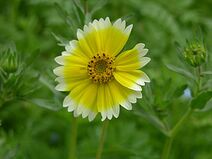Layia platyglossa
| Layia platyglossa | |
 | |
| Light: | |
| Moisture: | |
| Soil pH: | 5.6-8.4 |
| Height: | 1' |
| Speed: | Fast |
| Blooms: | Mid Summer-Early Fall |
| Native to: | |
| Nectary | |
| Edible Rating: | |
| Tea: | Yes |
Layia platyglossa (common name: 'coastal tidytips)
Propagation: Seed - sow March/April in a greenhouse. Prick out the seedlings into individual pots as soon as they are large enough to handle and plant them out in early summer.
Alternatively, if you have sufficient seed it is possible to sow in situ during April/May.
Cultivation: A fast-growing plant[1], it succeeds in ordinary garden soils[2] and also in poor soils[1]. It requires a very well-drained soil[1], preferring to grow on a dry sunny bank[3].
A frost tender annual, it does not thrive in areas with hot humid summers[3].
Range: South-western N. America - California.
Habitat: Grassy flats by the coast, below 100 metres[4].
Edibility: Seed - cooked. It can be used as a piñole[5][6], or can be ground into a powder and used with other ground seeds in a mush or porridge[7]..
Pollinators: Insects
Soil: Can grow in light and medium soils.
Drainage: Prefers well drained soil.
Flower Type: Hermaphrodite
Also Known As: Blepharipappus platyglossus.
Links
References
- ↑ 1.0 1.1 1.2 Brickell, Christopher. The RHS Gardener's Encyclopedia of Plants and Flowers. Dorling Kindersley Publishers, 1990.
- ↑ Chittendon, Fred. RHS Dictionary of Plants. Oxford University Press, 1951.
- ↑ 3.0 3.1 Huxley, Anthony. The New Royal Horticultural Society Dictionary of Gardening. MacMillan Press, 1992.
- ↑ Munz, David. A California Flora. University of California Press, 1959.
- ↑ Tanaka, Tyōzaburō. Tanaka's Cyclopaedia of Edible Plants of the World. Keigaku Publishing, 1976.
- ↑ Yanovsky, Elias. Food Plants of the North American Indians Publication 237. US Department of Agriculture.
- ↑ Moerman, Daniel. Native American Ethnobotany. Timber Press, 1998.